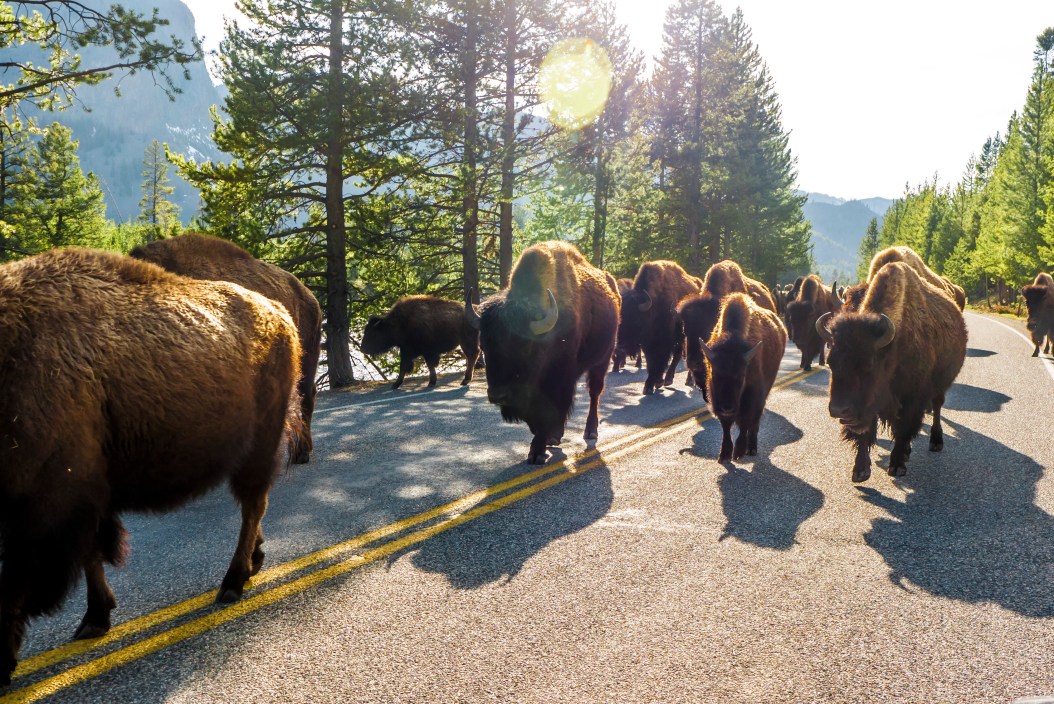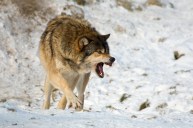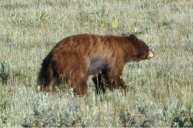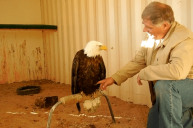There are many reasons to visit Yellowstone National Park, but the high chance you might see a bison, elk, or other animal is often top of the list. The problem: Many visitors don't know how to safely interact with the wildlife—emphasis on wild.
In the last month alone at Yellowstone, we've seen tourists try to take selfies with wild bison and try to pet them, endangering themselves. Others have tried to "help" baby animals, unaware their actions were deathly: One visitor put a baby elk in their car and drove it to the police station, all-but ensuring the baby would never find its mother again. Another man tried to help a calf separated from its herd by pushing it up to the main road, but the calf was then rejected by its herd for human contact and conditioned to humans, so it had to be euthanized.
This is so common at Yellowstone, there's an entire Instagram dedicated to ignorant visitors called Tourons Of Yellowstone.
Why is it worse at Yellowstone? Likely because of the close-proximity that people have to wild animals, certified wildlife biologist Ryan Wilson, PhD, tells Wide Open Spaces. "Large herds of bison occur right along the road, making it easy for people to get close to them and make poor decisions."
According to the National Park Service, the bison population at Yellowstone National Park fluctuates between 2,300 and 5,500, with herds breeding in Lamar and Hayden Valley. The park is also home to 67 species of mammals and hundreds of species of birds, fish, and reptiles.
Considering the above, it's safe to say: If you're visiting Yellowstone, the number one thing you need to know is to leave the wildlife alone.
While wildlife sightings might be exciting, Wilson (and the National Park Service) highly discourages approaching any wildlife to pet them, feed them, or even be near them. Here's why:
1. Animals in national parks are unpredictable.
"I have seen large groups of people get out of their cars watching black bears along the side of the road," Wilson says. "They can be unpredictable, and I don't think people appreciate how quickly a bear can run."
Approaching a bear can open up the opportunity for the animal to charge and maul at you.
2. Animals can carry diseases you can catch.
It's simple: Wild animals are wild and can pose a danger to humans.
"They should never be approached or touched because they can transmit diseases or be aggressive," Wilson explains.
3. Distressed and "abandoned" animals are natural.
Even if an animal is in distress or a baby is separated from its mother, Wilson says its best to never intervene because it can lead to significant fines and bad outcomes for the animal.
Instead, hit up a park ranger to determine if human intervention is even necessary and if so, the appropriate crew can accomplish the task at hand.
4. Feeding or touching animals can lead them to be euthanized.
You might think petting a bison or carrying a baby calf over an obstacle is helpful—but the smell of human touch on an animal can cause the herd to reject the animal.
What's more, if that unpredictable animal turns aggressive on you because you got too close, this can potentially lead to euthanization of the animal if things go south.
Lastly, feeding wildlife can prevent animals from going about their natural behavior, making it harder for them to survive. One research study found that black bears commonly break into minivans in Yosemite, hypothesizing that unsecured food and its odors led the bears there.
What's more, human interaction may habituate the animals to humans and cause problems that could ultimately lead to the animal being euthanized, says Wilson. That was part of the reason the bison calf had to be euthanized late last month: After being abandoned by its herd, the calf was causing "hazardous situations" by approaching cars and people in the roadways, likely as a direct result of it being handled by an unknowing human.
"The biggest problem is that we try to manage national parks to remain natural and wild places. So when humans act inappropriately and cause animals to act aggressively or problematically, they are no longer able to be a wild animal. Thus, we impact the overall natural functioning of the park," Wilson says.
The Exception: When It's Okay to Interact with Wildlife
In a National Park, there are no exceptions for visitors. National Parks are meant to be spaces for people to enjoy the natural beauty. This includes respecting wild animals and their natural habitats.
Moral of the story? Just. Don't. Do. It. Leave the wildlife alone.
Read More: Less Busy & More Beautiful Alternatives to Yellowstone National Park




